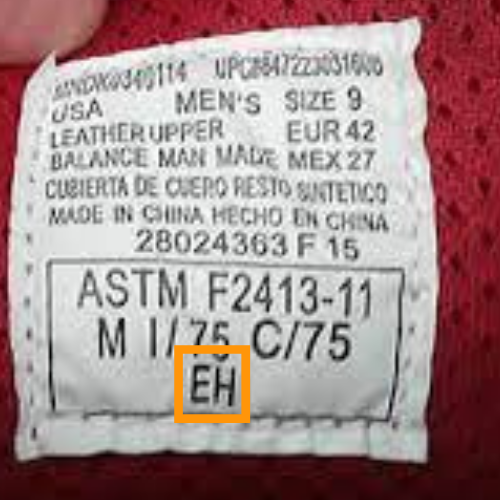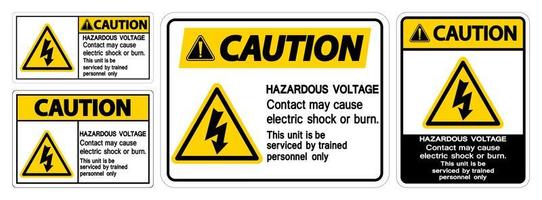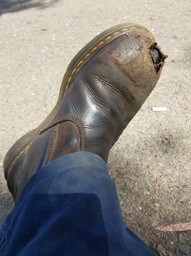Electrical hazard boots are required by OSHA in the United States if your job involves working with electricity or power tools that could cause an electric shock. These boots must be worn when using these types of equipment. They should also be used whenever there is a risk of contact between electrically charged parts of machinery and any part of your body. This includes situations where workers may need to work near overhead lines while doing maintenance or repair work.
Safety footwear is a vital part of any worker’s personal protective equipment kit, and should be worn at all times when working around electricity or other hazardous materials. Electrical hazard rated safety boots provide protection against electric shock by providing an effective barrier between your feet and dangerous voltages that can cause serious injury or even death if not protected properly. Safety toe boots can be either composite toe or a steel toe, composite toes do not conduct electricity or set off metal detectors.
The International Standards Organization has developed standards for PPE to ensure safe work practices across industries worldwide.
How do you tell if boots are electrically rated?
Electrical Hazard (EH) rated boots will have the letters “EH” on the boot’s tongue, usually next to the ASTM rating. ASTM is an organization that creates globally accepted, recognized, and used standards by governments and industries throughout the world.

What are Static Dissipating Work Boots
Static dissipation boots are designed to reduce the build up of electrostatic charges on your body while wearing these boots. The best way to describe this would be similar to how an anti-static mat works. It’s basically a material that absorbs all the static energy generated by your body. You could think of it as a rubber floor mat that prevents you from getting shocked by standing on top of it. There are many different types of materials used to make these mats including polyurethane foam, neoprene, nylon mesh, cotton fabric, etc.
The boots themselves release static build-up while you’re wearing them.
How are EH boots different from Static Dissipating (ESD) Boots
In areas which possess higher risks, OSHA demands ASTM F1117. How are EH boots different from Static Dissipating Boots?
EH boots are specifically developed to provide protection from electric shock. They do not dissipate static charge as static dissipating boots do but instead they absorb it. Electrical dissipating boots will dissipate electricity as you walk. Think of when you walk on carpet in socks, you can generate a good amount of electricity by walking around and then discharging (shocking) either a person or object by touching them.
You can imagine when working with explosive chemicals or objects you don’t want to risk any kind of explosion through the static shock you can generate by walking around. Static dissipating boots will discharge that shock unlike electrical hazard boots.
Main causes of electrical injury or electrocution
EH rated safety shoes are isolating safety shoes and cannot be confused with conductive safety shoes, like ESD or antistatic safety shoes, which have a whole other purpose.
Main causes of electrical injury or electrocution:
• Faulty wiring – This includes damaged cables, loose connections, broken cable ties, exposed live parts, faulty grounding systems, etc.
• Improperly grounded tools – These include ungrounded metal objects that come into contact with energized lines, improperly grounded hand held devices, etc.
• Insufficient protection – Inadequate personal protective equipment, lack of training, poor work practices, failure to follow procedures, etc.
Having electrical hazard rated boots is meant to protect yourself from being electrocuted when your feet touch one of the dangerous hazards mentioned above and especially important if you’re working around electricity on a daily basis such as electricians.
Electrocutions are one of the most frequent electrical hazards in construction sites. electrocution can be fatal if you are in direct contact with electric high voltage equipment. Electrocution causes over4,000 injuries and 300 deaths annually. Electricity flows through conductors including metals, water, earth, but also the human body. Usually the circuit between the wires and the electricity source is well maintained and the equipment works as intended.
Operators, or those in the area, who come into contact with the electricity can become part of the electric circuit in case of a malfunctioning machine. If a person is in direct contact with a “live” wire, live meaning this wire has electricity flowing though it, they can feel anything from a tingling sensation to an intense shock. Ultimately a fatal electrocution can occur dependent upon on the power flowing through that wire, frequency, and type (AC/DC) of electricity source. Dangerous voltages are over 50V AC or 120V DC.

When is Electrical Hazard Protection Compromised
The most common area boots are compromised is at the toe. When any part of the safety toe cap is exposed there is significant risk for injury and you need to either effectively cover that exposed area or get a new pair of safety toe boots.

What jobs need electrical hazard protection boots
Most safety toe boots now a-days are created with electrical hazard rated, so if you have steel toes already you’re most likely compliant with requirements. If you’re wondering which professions need electrical hazard boots we’ve created a short list below:
1. Construction workers
2. Electricians
3. Welders
4. Mechanics
5. Plumbers
6. Off shore workers
7. Machinists
Best Work Boots For Electricians
Finding the most reliable boots for electrical contractors involves considering a number of critical factors. Given that electricians operate in diverse work environments, it’s essential to prioritize safety requirements such as electrical hazard protection, as well as steel or composite toe caps. Durability and comfort are also non-negotiable, and the right pair of boots should offer proper cushioning and support, as well as high-quality materials that can withstand significant wear and tear. In addition, boots with slip-resistant soles are a must-have, given that electricians work in various conditions, including wet and slippery surfaces. By making an informed choice, electricians can significantly reduce the risk of workplace injuries and stay safe while on the job.
Conclusion
If you’re required to wear safety toe boots you’ll most likely need electrical hazard protection. You can tell if a boot is electrical hazard rated by looking at the tag within the boots next to the ASTM rating. If the boots are electrical hazard rated, the letters “EH” will be next to the rating. Electrical hazard rating means they meet requirement basic requirements to protect you from electrical hazards. Jobs that require electrical hazard boots include electricians, welders, construction workers, and any other occupation that requires safety toe boots.
